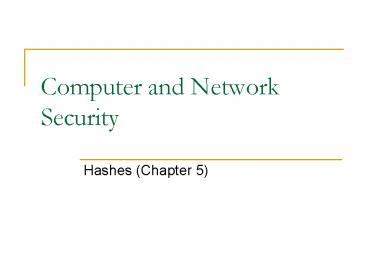Computer and Network Security - PowerPoint PPT Presentation
1 / 21
Title:
Computer and Network Security
Description:
Also called message digest function or one-way function, mapping an arbitrary ... Step 2: Append a 16-octet checksum to the message ... – PowerPoint PPT presentation
Number of Views:45
Avg rating:3.0/5.0
Title: Computer and Network Security
1
Computer and Network Security
- Hashes (Chapter 5)
2
Hash
- Also called message digest function or one-way
function, mapping an arbitrary-length message to
a fixed-length output (message digest)
3
Randomness Requirement
- For an arbitrary change in the input, every bit
in the output has 50 chance to change (about
half the bits should differ) - Computationally impractical to find two messages
with the same digest - Computationally impractical to find a message
with a given message digest
4
Digest Length
- If the digest length is n bits long, it takes
O(2n/2) to find two messages with the same
digest. (Page 119-120)
5
What Hash Can Do
- Authentication
- Integrity (MAC)
- Privacy (Encryption)
6
Authentication
- Page 123
7
Encryption
- Generate one-time pad as b1, b2, b3,
- b1 MD(KIV),
- b2 MD(Kb1),
- b3 MD(Kb2),
- Then, XOR the message with the one-time pad bit
sequence.
8
Using Secure Key for Hashing
9
MD2
- Input arbitrary number of octets
- Output 128-bit message digest
- Step 1 Pad the message to be a multiple of 16
octets - Step 2 Append a 16-octet checksum to the message
- Step 3 Process the message, 16 octets at a time,
to produce the message digest.
10
Step 1 Padding
11
Step 2 Checksum
12
MD2 ? Substitution Table
13
Step 3 Produce Message Digest
14
MD4, MD5, SHA-1
- Input arbitrary number of bits
- Output 128 bits for MD4 and MD5, 160 bits for
SHA-1 - Step 1 Pad the message to be a multiple of 512
bits (16 words, 64 octets) - Step 2 Process the message, 512 bits at a time,
to produce the message digest
15
Step 1 Padding
16
Step 2 Produce Message Digest
17
SHA-1 Digest Function
18
Problem of keyed hash digest(Key m)
- A problem maker gets m, digest(Key m)
- It first pads m according the used hash function,
and then adds another message M at the end. The
result is m pad M. - digest(Key m pad M) can be calculated from
digest(Key m pad), which is the intermediate
digest.
19
Solutions
- Use digest(m Key)
- HMAC
20
More on Hash
- Exercise 1 variants of
- One encryption after XORing message blocks
- Use constant as key
- Exercise 2 use CBC for hash
- Is it secure?
- Use message blocks as keys
21
More on Hash
- Secure Hash Construction from Block Cipher

